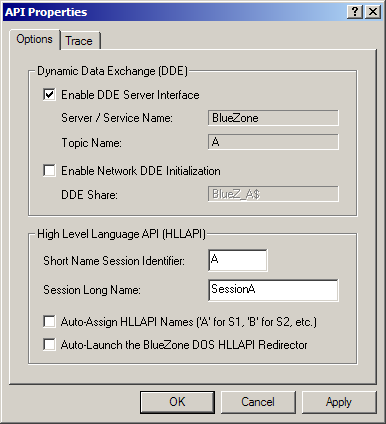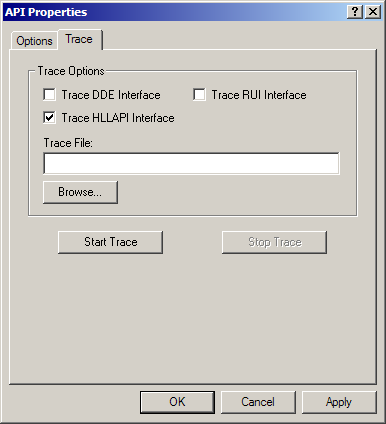
|
Configuring BlueZone |
Chapter 5 |
BlueZone supports DDE and HLLAPI to allow external applications such as GUI interfaces, scripting engines, and input automation programs to input data to and extract data from IBM host screens. The primary interface is through the DDE server. The BlueZone implementation of HLLAPI communicates with BlueZone through this DDE interface and is EHLLAPI/WHLLAPI compliant.
The API Properties dialog is used to configure BlueZone to work with external programs. To launch the API Properties dialog, go to the BlueZone MenuBar, and select Options:API.
Typical applications that use BlueZone's API interface use a HLLAPI interface to communicate with BlueZone. In order for BlueZone to communicate with a HLLAPI application via BlueZone's DDE Interface, you must enable BlueZone's DDE Interface.
The API (Application Program Interface) Properties, Options tab allows the configuration of DDE and HLLAPI items.

Illustration 5-14
The Dynamic Data Exchange Group is used to configure DDE operating parameters.
Enable DDE Interface: Enable to allow the BlueZone session to function as a DDE Server. DDE client applications can communicate with DDE servers to exchange data. This option must be enabled in order for BlueZone to communicate with HLLAPI client applications.
Server / Service Name: Displays the Server / Service Name as “BlueZone”.
Topic Name: Displays the session’s DDE Topic Name. The Topic Name can be changed by configuring the HLLAPI Short Name Session Identifier.
Enable Network DDE Initialization: If checked, BlueZone will modify registry settings and invoke NETDDE.EXE to enable DDE client applications to communicate with BlueZone over a Local Area Network (LAN).
 NOTE
Only use this option when the HLLAPI application is on a computer separate
from the computer that BlueZone is running on.
NOTE
Only use this option when the HLLAPI application is on a computer separate
from the computer that BlueZone is running on.
DDE Share: Displays the DDE Share Name that NETDDE uses to establish a DDE connection over the Local Area Network(LAN).
The High Level Language API group is used to configure HLLAPI operating parameters.
Short Name Session Identifier: Used to set the HLLAPI identifier for the BlueZone session. The HLLAPI Short Name Session Identifier is also used as the DDE Topic Name.
Session Long Name: Used to set the HLLAPI description name for the BlueZone session.
Auto Assign HLLAPI Names ('A' for S1, 'B' for S2, etc.): If enabled, BlueZone will automatically associate the Short Name Identifier to a session number 'A' for S1, 'B' for S2 and so on.
Auto-Launch the BlueZone DOS HLLAPI Redirector: If enabled, BlueZone will run/close the BlueZone DOS HLLAPI Redirector program each time the BlueZone DDE Server initializes/deinitializes.
The API Properties, Trace tab allows the user to trace problems encountered while using the DDE and HLLAPI interfaces. To get to this option, click Options:API from the BlueZone MenuBar and click on the Trace tab.

Illustration 5-15
The Trace Options group is used to create API trace files.
Trace DDE Interface: Enable to trace DDE conversation transactions.
Trace HLLAPI Interface: Enable to trace HLLAPI function calls and return values.
Trace File: Used to specify a trace file name for API tracing.
Browse: Displays a dialog used to select the directory and file name. BlueZone provides a Traces directory in the BlueZone installation directory.
 CAUTION!
This dialog
must contain a valid path or the trace feature will not work.
CAUTION!
This dialog
must contain a valid path or the trace feature will not work.
Start Trace: Used to start the API trace.
Stop Trace: Used to stop the API trace.
 SEE
The DDE.H Text File located in the DOCS
folder of the BlueZone CD-ROM, for more information about writing DDE
applications to communicate with BlueZone.
SEE
The DDE.H Text File located in the DOCS
folder of the BlueZone CD-ROM, for more information about writing DDE
applications to communicate with BlueZone.
 SEE
The
IBM EHLLAPI Programmer’s Manual
(available from IBM) or the Microsoft
WOSA HLLAPI Manual (called WOSA HLLAPI 1.1.doc) located in the
DOCS\WHLLAPI folder of the BlueZone CD-ROM, for information about writing
HLLAPI applications to interface with BlueZone. Sample
Visual Basic and C applications are available to aid developers writing
HLLAPI applications.
SEE
The
IBM EHLLAPI Programmer’s Manual
(available from IBM) or the Microsoft
WOSA HLLAPI Manual (called WOSA HLLAPI 1.1.doc) located in the
DOCS\WHLLAPI folder of the BlueZone CD-ROM, for information about writing
HLLAPI applications to interface with BlueZone. Sample
Visual Basic and C applications are available to aid developers writing
HLLAPI applications.